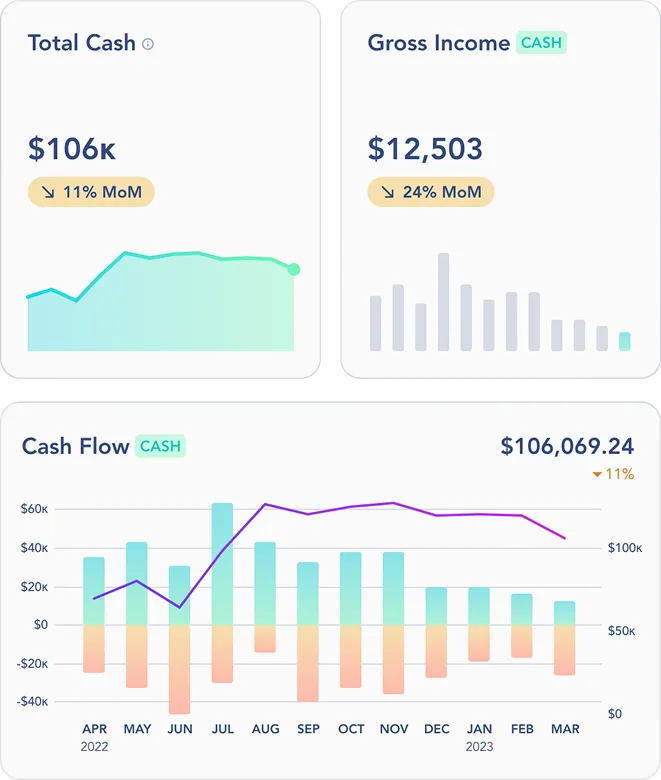
Investor Reporting: Best Practices for More Effective Investor Updates
 Bebe Kim
Bebe Kim
Investors want frequent updates on how they’ve spent their money. Reporting can assure them that they’ve made the right decision in supporting a startup.
However, not all reporting is created equal, and outdated, hard-to-read, or misleading reporting can disrupt the relationship with investors and cause them to distrust those managing startup funds.
In this age of increasing data volume and a demand for more timely analysis, here’s what you should know about investor reporting and how it supports sound financial action.
What is investment reporting?
Investment reporting is the act of giving detailed information and analysis about an asset or group of assets (such as a portfolio), as well as a startup company or project. The information provided acts as an accounting of past and present performance and often seeks to provide context for what could happen in the future.
Because this is often the only communication investors get on an ongoing basis, they place a deep importance on this reporting and could use it to further invest in the project or sell off their interest.
Why is investing in investor reporting worth it?
We live in a time when people want information almost immediately, and investors are no different. They want to know how their investments are doing so they can navigate market changes and make the right choices to grow their wealth.
Investor reporting is a key piece of this informed approach, as it supports the following goals:
Transparency
Without reporting, investors don’t know what’s going on behind the scenes, how their money is invested, and the effect individual actions have on their overall portfolio.
On the other hand, more robust reporting shows investors there’s nothing to hide, and they can trust startups with their most prized assets. If something goes wrong, there’s a digital paper trail through reporting to help them retrace steps and avoid similar mistakes in the future.
Compliance
Much of the investing world is governed by regulations, and reporting can meet the requirements set by state and federal regulators. It’s also necessary to avoid potential legal issues, especially if there’s a question of how money was invested or managed.
The Securities and Exchange Commission (SEC) also sets its own standards for reporting. While the reporting required by the SEC may be different from what a startup provides its investors, investor reporting can be a part of compiling and storing that data to make SEC compliance easier.
Growth tracking
For startups, growth is everything. Investors want to see how their capital is fueling the company's expansion and development. Regular, detailed reporting allows startups to:
- Showcase key performance indicators (KPIs) that demonstrate progress
- Highlight milestones achieved, such as user acquisition targets or product development stages
- Illustrate how funding is being utilized to drive growth
- Compare current performance against projected goals
By providing this information, startups can keep investors engaged and excited about the company's potential, which can be crucial for securing future funding rounds.
Building investor relationships
Startups often rely on strong relationships with their investors for more than just capital. Many investors bring valuable expertise, industry connections, and mentorship. Robust investor reporting helps to:
- Foster trust by maintaining open lines of communication
- Demonstrate professionalism and organizational maturity
- Provide opportunities for investors to offer strategic input
- Create a foundation for long-term partnerships that can benefit the startup throughout its lifecycle
Regular, high-quality reporting shows investors that the startup values their involvement and sees them as partners in the company's success, not just sources of funding.
What should be in an investor report?
Reports vary depending on the type of assets and how the investment manager chooses to share data, but you can expect to see the following information summarized in reports to investors in a startup.
Executive summary
This is the "TL;DR" version of the report, showing the most important takeaways for investors to understand where their assets stand and any recommendations to act upon. Significant changes, user growth, and asset updates will be included here.
Highlight growth in revenue, users, downloads, or other relevant KPIs, as well as the overall strategic direction of the startup. It's also the ideal place to include staff changes, like the new hire of talent who can help support a critical project. If you only had 2-3 minutes to share key facts about your startup with an investor, that information would go here.
Performance metrics
This is what investors will find most interesting, as it tells them in detail how your startup is really doing. Details covered under performance metrics include:
- User acquisition and retention rates
- Revenue growth and breakdown by product/service
- Burn rate and runway
- Customer acquisition cost (CAC) and lifetime value (LTV)
- Market share and competitive positioning
When an investor wants to know why their investments in your startup increased or decreased in value, they should be able to look to this section for answers. You can drill down into user adoption by segment or revenue by service offering to provide a comprehensive view.
Product development
This section gives investors insight into how the product is evolving and how well it's meeting market needs. It might include:
- Progress on the product roadmap
- Key features launched or in development
- User feedback and product-market fit indicators
- Technical challenges and solutions
This is a great place to get investors excited for what’s to come as you show off features that are on their way or new markets you’ll be entering soon.
Financial overview
Similar to the asset allocation in traditional investment reports, this section provides a breakdown of how the startup's funds are being utilized. It reassures investors about the company's financial health and strategy.
In this section, try to include:
- Revenue breakdown and projections
- Expense analysis
- Cash flow statement
- Balance sheet highlights
- Funding status and plans
Market analysis
This section provides investors with crucial insights into the broader context in which the startup is operating. It helps them understand the potential for growth and the challenges the company may face.
Key components include:
- Target market size and growth potential
- Competitive landscape updates
- Regulatory or industry trends affecting the startup
- Emerging opportunities or threats in the market
- Analysis of customer segments and their evolving needs
Investors can use this information to gauge just how viable a startup is in the long-term and its potential for capturing future market share.
Operational updates
This section offers a snapshot of the company's internal workings and progress. It demonstrates how the startup is scaling and improving its operations to support growth.
For this section, you can include:
- Team growth and key hires
- Partnerships or strategic alliances formed
- Operational efficiencies achieved or in progress
- Challenges encountered and steps taken to address them
- Updates on office space, equipment, or other infrastructural changes
These updates give investors confidence in the startup's ability to execute its plans and manage growth effectively.
What are the hallmarks of a great investor report?
A truly great investor report makes it easy for investors to see why your company is the right choice for further funding. Here are some characteristics of an excellent report.
Clear and concise
Anyone should be able to get the highlights from an investor report, not just those with extensive financial knowledge. The report shouldn’t ramble, be full of jargon, or jump around. If the investor only has a few minutes to scan the report, they should know where to look first for the most important information.
Comprehensive
At the same time, a great report leaves nothing out that an investor would ask about. It should answer their questions and not put them in a position to follow up with their manager for essential information.
Metrics like market share, user growth, and risk should be covered extensively so the investor feels they understand your business as well as you do.
Visual and professional
While the most recent studies on the effectiveness of illustrations are already a few years old, the fact remains: Visuals play a vital role in communicating often difficult concepts.
By using visuals in investor reporting, you do two things:
- Meet people where they are at in their level of understanding and make your reports accessible
- Ensure there are no misunderstandings, which can strain the startup/investor relationship
In the past, creating compelling visuals required knowledge of complex design tools, something that most founders didn’t have time to learn.
Today, tools like Digits automate the visual creation process. It puts relevant, bold, and insightful visual elements into reports where they are likely to have the best effect. Instead of stressing over how large to make a pie chart, managers can focus on the best ways to grow their investors’ money.
Customized
Most investor reports contain the same basic information, such as burn rate or runway, but beyond these basics, investors may choose to see any number of metrics, with some being very specific to that individual investor’s industry or business needs.
By offering customized reports, you can truly answer all of your investors’ questions and instill in them the confidence they need to continue investing in your venture. Whether it’s the data presented in the reports or simply the order in which metrics are listed, finding ways to customize reports can create more trust in your leadership and brand.
5 best practices for better investor reports
Now that you know what goes into an investor report and makes it stand out, here are some tips for achieving incredible results.
1. Create a snapshot, not an encyclopedia
While it can be tempting to list out every activity that’s occurred since the last report, investors initially need to see the bottom line of how their investments performed so they can adjust their strategies accordingly.
So, what can you do if your investors want to see the nitty-gritty of your business? Give it to them.
It can be very difficult to fit all the important information on a page, and abbreviations and color coding only get you so far. Consider using interactive elements that can be clicked to open up additional windows, overlays, or graphs. This keeps the essentials front and center but allows investors to dig in deep when they want to.
Digits shows explorable data at the click of a button, so investors never have to leave the report to find answers. Even transaction-level data can be accessed.
2. Use data and visuals to tell your story
Reading through pages of text can be a turnoff for investors and risk them not taking your reporting seriously. To solve this issue, incorporate plenty of charts, graphs, and tables that summarize the main points of your reporting.
Visually compelling reports should be the norm, and your illustrations should be high-end and represent your brand well. Tools like Digits do this for you automatically, using the data you specify from each investor’s data and background, so you can spend less time creating those visuals.
3. Offer consistency
It can take an investor some time to acclimate to a new reporting format. However, once they’ve been getting them for a while, they’ll know what page to turn to first to get the answers they seek.
If you provide a consistent format, including visuals, you ensure they work less to find insights. To reduce confusion, be sure to keep data points the same color and stick to the same abbreviations or terminology throughout.
4. Focus on past, present, and future
Reports can be used to see how your company has performed in the past, but that shouldn’t be all they showcase. A great report is also a great storytelling vehicle where you can convince investors that staying with you for the long haul is in their best interests.
Things you can do to boost this feature of your reporting include:
- Don’t emphasize short-term results; instead, provide context and recommendations for long-term success.
- Consider all relevant data. Don’t cherry-pick just the time periods or investments that make you look the best.
- Provide benchmarks. Past performance should be compared against relevant benchmarks to help the investor see how external factors have and may continue to affect results over time.
- Make cautious predictions. Investment managers can use data to forecast, to a degree, and the more data that supports your predictions, the better.
- Personalize action items. Each investor has their own goals for their investments, and some may not want to earn in the same way and at the same speed. Consider their goals when making predictions, as well as offering advice. Irrelevant action items need not be included in your report.
Reports should be a holistic view of investments, including lessons learned and possible opportunities for the future.
5. Automate what you can
Creating investor reports can take a lot of time and energy. By automating this process, you can lift a burden from your shoulders.
Plus, with a tool like Digits, you can ensure all of your data gets represented accurately and in near real time. This will not only impress many investors who are used to long wait times for current financial data but also give them the information they need to be fully briefed on your startup.
Great reporting starts with better data
Reporting takes a sea of investor data and turns it into relevant, actionable insights, but it can only do this if the data has the following features:
Error-free. Just as human errors can derail reporting, digital errors can, too. Checking the data sources to be sure they import and display correctly ensures high-quality results.
Timely. Outdated information can jeopardize reporting and leave managers to give inaccurate advice. With many data sources imported throughout the day, there’s no reason to build reports on old data. (Digits live insights and KPIs give you up-to-the-minute information, so reports offer the most current portfolio view.)
Secure. While it doesn’t directly affect reporting quality, any data collection efforts should follow security and privacy standards. Partner with a trusted technology to create automated reports and ask what they do to follow data best practices.
Want to see automated reporting in action? Sign up for a demo of Digits to see how AI accounting can give you access to the data and data insights you need to impress your investors.


